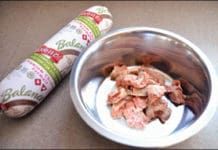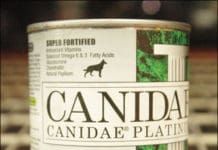How-To Books for Feeding Raw Diets
When someone becomes interested in feeding their dog a homemade diet, I always advise them to read at least one book on the subject before getting started. But which one should you choose? Guidelines run the gamut from diets that have been analyzed to ensure they are complete and balanced, to those that are dangerously inadequate. How do you tell the difference? I decided to check out the homemade diet books that are currently available. Some of them I’d read before, but wanted to take a fresh look at; others were new to me. It’s been an eye-opening experience.
Whole Dog Journal’s Commercial Frozen Raw Dog Food Review
The more I've learned about the meat used in pet food, the more I've come to admire commercially produced frozen raw diets for dogs. The meat and poultry used in most of these diets are far fresher and more wholesome - far more like what most of us would think of as "meat" - than most animal protein ingredients in dry (or even canned) pet foods. The products tend to produce terrific results in the dogs who consume them. Whether this is due to the ingredient quality or the fact that this type of diet is more biologically appropriate for canines than dry foods is anyone's guess. My guess is that both factors contribute to the success of the products.
Dog Breeders Who Only Feed Raw Dog Food Diets
You know you’ve been feeding raw for a long time when it no longer seems like a radical, ground-breaking, or – ubiquitous adjective for beginners – scary way to feed. When I started feeding raw – a dozen years and three generations of Rhodesian Ridgebacks ago – it was the Middle Ages of raw feeding. Ian Billinghurst’s Feed Your Dog a Bone was the hard-to-find illuminated manuscript (the lax editing could have stood some sprucing up by Benedictine monks), and everyone used the unfortunate acronym BARF, which stood for “bones and raw food” (or, later, the loftier-sounding “biologically appropriate raw food”). No commercial raw diets were available, and new converts dutifully ordered their Maverick sausage grinders over the Internet. The instruction booklet said the table-top grinder couldn’t be used on any bones harder than chicken necks or wings, but everyone ignored that.
Are Raw-Fed Dogs a Risk?
Delta Society is one of the largest and best-known organizations that registers and insures “pet therapy” volunteers and their companion animals. Pet/handler teams – known as Pet Partners – brighten lives in hospitals, nursing homes, group homes, schools, pre-kindergarten programs, libraries, jails, women’s shelters, homeless shelters, senior centers, adult day programs, and a host of other facilities. But on May 19, Delta Society triggered a firestorm of controversy, complete with conspiracy theories, angry denunciations, frustration, and confusion, when it announced that effective June 30, “any dog or cat from a household where raw protein food is fed is not eligible to be a Delta Society Pet Partner.” Delta’s Raw Protein Diet Policy raises serious questions about the safety of feeding raw food regardless of an animal’s pet-therapy status.
Using Your Dog’s Bowl As a Training Tool
You may think feeding your dog is a simple matter of dumping food in his bowl and plopping it down on the floor in front of him. You may be wrong. Mealtime is fraught with significance for your dog, and loaded with opportunities for you to influence his health and his behavior. Failure to take advantage of these could actually contribute to the development and/or escalation of problems that might otherwise be averted. A few deliberate decisions and choices on your part can go far in creating harmony in your home.
Problems With Artificial Preservatives in Dog Food
Recently we've heard from a number of dog owners who are concerned about the use of ethoxyquin to preserve fish meal that is used in dog foods. We've had one e-mail forwarded to us several times expressing worry over links between undeclared ethoxyquin in pet foods and canine cancer. We have long advised owners to pass over dog food that contains artificial preservatives such as butylated hydroxyanisole (BHA), butylated hydroxytoluene (BHT), tert-butyl hydroquinone (TBHQ), propyl gallate, and ethoxyquin, in favor of products made with natural preservatives, such as tocopherols (vitamin E), citric acid (vitamin C), and rosemary extract. Though synthetic preservatives were once as recently as 20 years ago the usual preservative found in all dry dog foods, today, they appear only on the labels of low-cost and lower-quality products.
Whole Dog Journal’s 2010 Dry Dog Food Review
Here is Whole Dog Journal's Approved Dry Dog Foods List for 2010. All these products meet our selection criteria - including our newest criterion, that the company discloses the name and location of its manufacturers. Today's dog owners have more and more choices of better-quality foods including many featuring organic or "wild" ingredients.
How to Identify and Pick Top Quality Dog Treats
Surely there is no such person as a dog owner who never gives his or her dog a treat. We all like to see our dog's tail wag, and his face light up with attentive anticipation, right? But how do you know that the treats you give him are healthy? It's actually pretty simple. As with every food you buy (for yourself or your dog), it's all about the ingredients. If you do not already read the label of every food item you consider buying, get in the habit! Most of the information you need to know in order to determine the product's quality is legally required to appear on the label. Ingredients are listed on the label by weight; there is more of the first ingredient on the list present in the treat than the second ingredient, and so on. (One exception: If equal amounts - by weight - of different ingredients are present, the manufacturer can list those ingredients in any order; that is, as long as they are still in order relative to the other ingredients). The first few ingredients on the list are the most significant; since they comprise the majority of the content, they should be especially high in quality.
Homemade Low-Fat Dog Food Diets
Seven-year-old Annie looks terrific now, but she weighed 20 pounds less when first diagnosed with EPI. Annie's owner enjoys cooking for her dogs now that she has learned how to streamline the shopping, preparation, and storage. Keely is an active agility dog. She requires a low-fat diet to prevent ill effects of hyperlipidemia, which is common in Miniature Schnauzers. Rowdy, a 12-year-old Rhodesian Ridgeback, needs a low-fat diet that doesn't trigger painful gas attacks." Rocky is finally a good eater!"
Healthy Low-Fat Diets For Dogs With Special Dietary Needs
Some low-fat recipes for dogs are excessively low in fat, providing as little as 5 to 8 GFK, with as much as seven times more starches than meat. With very few exceptions, its not necessary to feed such an extremely low-fat diet to dogs recovering from or prone to pancreatitis or with other forms of fat intolerance, nor is such a diet likely to be nutritionally adequate, regardless of how many supplements you add.
Pet Food Politics
Were you one of the millions of concerned dog owners who struggled to follow and make sense of the pet food recalls last year? If so (and what dog owner wasn’t), I predict that you’ll find Pet Food Politics: The Chihuahua in the Coal Mine to be the most riveting book you’ll read this year. Recently released by the University of California Press, Pet Food Politics provides an in-depth look at the record-setting (and not in a good way) pet food recalls in 2007. We have a review of the book, and an interview with the author, renowned food industry expert Marion Nestle, PhD.
Green Tripe for Dogs
Voss kept her dogs supplied with fresh tripe


















